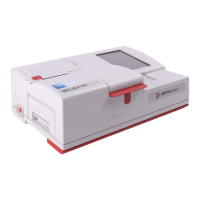9-2 Operator’s Manual – OPTI CCA-TS2
9 OPERATING PRINCIPLES
9.3 Operation
The OPTI CCA-TS2 is a microprocessor-based instrument measuring optical uorescence.
A disposable, single-use cassette contains all the elements needed for calibration, sample measurement
and waste containment. After scanning the calibration information specic to a cassette into the
instrument by holding the cassette package in front of a convenient bar code scanner, the cassette is
placed into the measurement chamber. The analyzer warms the cassette to 37.0 ± 0.1 °C, and performs a
calibration verication on the sensors for PCO
2
and PO
2
by passing a precision calibration gas mixture
across the optode sensors. The pH and electrolyte channels are calibrated with precision buffer solution
contained in the cassette. The tHb and SO
2
channels are factory-calibrated. When calibration is veried,
the analyzer aspirates the blood sample into the cassette and across the optode sensors. Fluorescence
emission is then measured after equilibrating with the blood sample. After a single measurement, the
cassette, containing the blood sample, is removed from the analyzer and discarded. The analyzer contains
no reagents, blood or waste.
During each measurement, light originating from lamps in the analyzer is passed through optical lters so
that photons of a specic color are transmitted to the sensors, causing them to emit uorescence.
The intensity of this emitted light depends upon the partial pressure of oxygen (PO
2
), carbon dioxide
(PCO
2
), hydrogen ion concentration (pH), electrolyte concentration (Na
+
, K
+
, Ca
++
, Cl
-
) or metabolite
concentration (glucose, BUN (urea), lactate) of the blood in direct contact with the sensors, as described
above. The light emitted by the uorescent sensors is measured by the analyzer after passing through
lenses and additional optical components. A lter is used to isolate specic colors of interest from this
returning light for measurement by a light detector.
For tHb and SO
2
, red and infrared light from one LED and two laser diodes is directed via dichroic
beamsplitters and optical waveguides onto and through an optically polished window to the blood in the
cassette over the O
2
sensor. This light is partially absorbed and reected by the erythrocytes and sensor
overcoat then reected back up into the instrument, traveling via an optical waveguide to a photodiode.
The intensity of light reected back at each wavelength varies in a well-dened way with the blood ctHb
and SO
2
, and is used in their measurement.
The output signal of the detectors is converted by the microprocessor to a numeric readout in conventional
units of measure and displayed on the front of the device. Other values commonly used for the assessment
of oxygen and acid-base status are calculated from these measured values.

